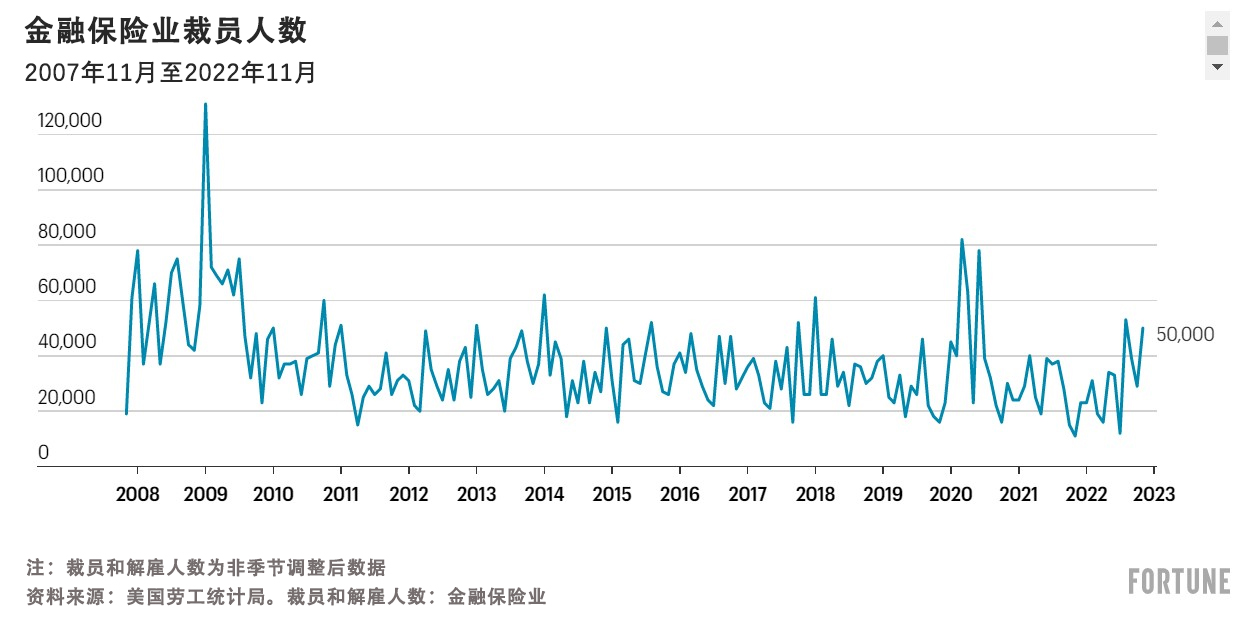高盛和亚马逊裁员并不意味着美国经济前景一片黑暗

2023年伊始,有关裁员计划的诸多新闻,似乎成为美国社会关注的首要问题。从科技行业开始的裁员潮,现在似乎蔓延到其他行业,高盛集团(Goldman Sachs)上周刚刚宣布将进行大规模裁员。
这足以令普通上班族对自己的工作安全感到担忧,尤其是许多专家预测美国今年将陷入经济衰退。
尽管裁员的消息占据了媒体头条,但从美国的就业数据中,却看不出美国正在发生大规模裁员。失业率依旧很低。美国劳工统计局(Bureau of Labor Statistics)的数据显示,2022年11月的裁员和解雇人数约为140万人。这似乎是一个很庞大的数字,然而过去两年,尽管各大媒体纷纷呼号未来一片黑暗,但美国的失业人数基本上维持稳定,没有出现大规模增长。

Indeed Hiring Lab的北美区经济研究总监尼克·邦克最近对《财富》杂志表示,实际上与新冠疫情之前相比,裁员率较低。以建筑业为例。过去六个月,建筑行业的平均裁员率为1.8%,是整个经济体综合裁员率的两倍以上。但这低于2019年2.9%的平均裁员率。
在某些行业,裁员和解雇人数可能发生变化。例如,从2022年10月到11月,金融保险业裁员人数增加了约19,000人。增长幅度确实较大,但并不是过去三年该行业裁员人数涨幅最大的一次。

科技行业在美国总体就业人口中所占的“比例较小”。因此,显然其他非科技公司在裁员方面的表现可能更好。此外,1月16日发布的高盛经济研究报告显示,科技行业在过去20年经历的多次大规模裁员,并不能代表整体经济趋势。
公平地说,现在更准确的说法是,数据并未显示裁员人数高涨。有专家指出,许多公司,尤其是科技公司,在裁员时会提前几周发布通知,并提供最长六个月的离职补偿。这意味着与裁员有关的数据可能滞后,等到这些被裁员工正式从公司的工资单中消失后才会有所体现。这可能导致数据滞后。
但高盛分析师最近评估了根据《工人调整和再培训通知法案》(Worker Adjustment and Retraining Notification)发布的提前裁员通知,虽然最近有更多公司发布这类通知,但依旧“略低于新冠疫情之前已经处于历史低位的比例”。有趣的是,高盛发现,许多最近失业的上班族以“健康的速度”找到了新工作。
高盛的分析师说道:“上述这些趋势表明,目前,劳动力市场可能会继续致力于再平衡,再平衡的主要方法迄今为止是有益的。”(财富中文网)
译者:刘进龙
审校:汪皓
2023年伊始,有关裁员计划的诸多新闻,似乎成为美国社会关注的首要问题。从科技行业开始的裁员潮,现在似乎蔓延到其他行业,高盛集团(Goldman Sachs)上周刚刚宣布将进行大规模裁员。
这足以令普通上班族对自己的工作安全感到担忧,尤其是许多专家预测美国今年将陷入经济衰退。
尽管裁员的消息占据了媒体头条,但从美国的就业数据中,却看不出美国正在发生大规模裁员。失业率依旧很低。美国劳工统计局(Bureau of Labor Statistics)的数据显示,2022年11月的裁员和解雇人数约为140万人。这似乎是一个很庞大的数字,然而过去两年,尽管各大媒体纷纷呼号未来一片黑暗,但美国的失业人数基本上维持稳定,没有出现大规模增长。
Indeed Hiring Lab的北美区经济研究总监尼克·邦克最近对《财富》杂志表示,实际上与新冠疫情之前相比,裁员率较低。以建筑业为例。过去六个月,建筑行业的平均裁员率为1.8%,是整个经济体综合裁员率的两倍以上。但这低于2019年2.9%的平均裁员率。
在某些行业,裁员和解雇人数可能发生变化。例如,从2022年10月到11月,金融保险业裁员人数增加了约19,000人。增长幅度确实较大,但并不是过去三年该行业裁员人数涨幅最大的一次。
科技行业在美国总体就业人口中所占的“比例较小”。因此,显然其他非科技公司在裁员方面的表现可能更好。此外,1月16日发布的高盛经济研究报告显示,科技行业在过去20年经历的多次大规模裁员,并不能代表整体经济趋势。
公平地说,现在更准确的说法是,数据并未显示裁员人数高涨。有专家指出,许多公司,尤其是科技公司,在裁员时会提前几周发布通知,并提供最长六个月的离职补偿。这意味着与裁员有关的数据可能滞后,等到这些被裁员工正式从公司的工资单中消失后才会有所体现。这可能导致数据滞后。
但高盛分析师最近评估了根据《工人调整和再培训通知法案》(Worker Adjustment and Retraining Notification)发布的提前裁员通知,虽然最近有更多公司发布这类通知,但依旧“略低于新冠疫情之前已经处于历史低位的比例”。有趣的是,高盛发现,许多最近失业的上班族以“健康的速度”找到了新工作。
高盛的分析师说道:“上述这些趋势表明,目前,劳动力市场可能会继续致力于再平衡,再平衡的主要方法迄今为止是有益的。”(财富中文网)
译者:刘进龙
审校:汪皓
News of upcoming layoffs seems to dominate the landscape as the U.S. rings in 2023. What started in the tech sector now seems to be gaining momentum in other industries, with Goldman Sachs announcing a major round of cuts just last week.
It’s enough to give the average worker more than a bit of anxiety about their own job security, especially given that many experts have predicted the U.S. will enter a recession this year.
But for all the headlines, national employment data isn’t backing up the story of massive layoffs. Unemployment is still fairly low. And in November 2022, there were about 1.4 million layoffs and discharges, according to data from the Bureau of Labor Statistics. Now, that may sound like a lot, but that number has remained relatively flat throughout the last two years—essentially with no real massive shifts upward even as the headlines scream doom and gloom.
Layoff rates are actually low compared to pre-pandemic years, Nick Bunker, economic research director for North America at the Indeed Hiring Lab, recently told Fortune. Take the construction industry, for example. Over the past six months, the average layoff rate in the construction sector was 1.8%, which is more than double the aggregate rate for the whole economy. But that's less than the 2.9% average layoff rate in 2019.
Within specific industries, layoffs and discharges can vary. The finance and insurance sector, for example, had an increase of about 19,000 layoffs from October to November 2022. It’s a jump, to be sure, but it’s not even the biggest spike seen in the last three years.
And the tech sector accounts for a “small share” of overall U.S. employment. So it stands to reason that other non-tech companies are perhaps doing better on the layoff front. Further, this particular sector has experienced many spikes in layoffs over the last 20 years that were not reflective of broader economic trends, according to a Goldman Sachs economic research report published on January 16.
Now, to be fair, it’s probably most accurate to say data isn’t showing a spike in layoffs yet. Some experts point to the fact that many companies, particularly in tech, provide several weeks of notice when it comes to layoffs and severance packages of up to six months. That means the data around discharges may be delayed until after those employees officially exit the payroll. That may be contributing to a lag in the data.
But then again, Goldman analysts recently reviewed advance layoff notices filed under the Worker Adjustment and Retraining Notification (WARN) Act and found that while these filings have ticked up recently, they remain a “bit below the already historically low pre-pandemic rate.” Interestingly, Goldman found that many recently unemployed workers have managed to find new jobs at a “healthy pace.”
“The trends above suggest that, for now, the labor market is likely to continue to rebalance mainly in the favorable way it has so far,” Goldman analysts write.













